Lifting bag
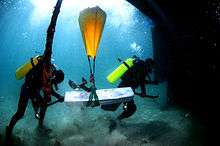 Israeli Navy Underwater Missions Unit transfers equipment using lifting-bags | |
| Uses | Lifting heavy objects underwater |
|---|---|
A lifting bag is an item of diving equipment consisting of a robust and air-tight bag with straps, which is used to lift heavy objects underwater by means of the bag's buoyancy. The heavy object can either be moved horizontally underwater by the diver or sent unaccompanied to the surface. Besides as a piece of diving equipment there are also lifting bags used on land for lifting cars or heavy loads or lifting bags which are used in machines. These lifting bags of the AS/CR type are for example used in the brake mechanism of rollercoasters.
It is advisable to select a lift bag with an appropriate capacity for the task at hand. If the lift bag is grossly oversized a runaway or otherwise out of control ascent may result. Commercially available lifting bags may also incorporate dump valves to allow the operator to control the bags buoyancy during ascent.
If a single bag is insufficient, multiple bags may be used, and should be distributed to suit the load.
Physics of buoyant lifting
The volume of the bag determines its lifting capacity: each litre of air inside the bag will lift a weight of 1 kilogram, or each cubic foot will lift about 62 pounds. For example, a 100-litre (3.5 cu ft) bag can lift a 100-kilogram (220 lb) underwater object.
A partially filled bag will accelerate as it ascends because the air in the bag expands as the pressure reduces on the ascent, following Boyles law, increasing the bag's buoyancy, whereas a full bag will overflow or blow off excess volume and maintain the same volume and buoyancy providing is does not descend. A bag which leaks sufficiently to start sinking will lose volume to compression and become less buoyant in a positive feedback loop until stopped by the bottom.
Breakout
The force required to lift a submerged object from the bottom can be split into two main components:
- Apparent weight, which is the weight of the object less the buoyancy of its displacement.
- Breakout forces due to embedment in the bottom, which can be negligible, or in some cases the major part of the load.
Once the object has broken free of the bottom, only the apparent weight remains, and a controlled lift requires a way of managing the sudden decrease of resistance to the lifting force. There are three basic ways this can be done:
- Use of mechanical or hydraulic excavation to loosen the sediments holding the load.
- Use of a "Dead Man Anchor" - a large heavy weight - and restraining cable to prevent the bag from moving away too far, so that the buoyancy can be corrected to more closely match the load.
- Use of shallow bags with long cables to the load to provide breakout, which will only lift a short distance before surfacing, after which the load can be lifted further by close coupled bags.
Stability of the load
Once a load is lifted off the substrate, it will rotate until the centre of gravity is in the position of lowest potential energy. If it is suspended from a single point, the apparent centre of gravity (corrected for inherent buoyancy) will be directly below the lift point. If it is undesirable for the load to rotate by a large angle as it leaves the bottom, the lifting point must be chosen to allow for this effect, and a multi-part sling or spreader bar may be needed, and it may be necessary to secure slings so they do not slip.
Types and construction
Underwater lifting bags are lifting equipment and as such may be required to comply with standards.
Open lift bags (parachute lift bags)
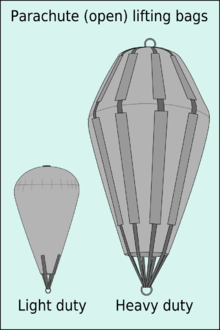
Parachute lift bags are open at the bottom. When full any extra or expanding air will spill out.
The shape of an open lifting bag should distribute the volume in a vertical rather than a horizontal direction so that the open end of the bag always remains underwater. If the open end reaches the surface, air will escape from the bag and it may sink.
The simplest version are two-sided bags, either joined round the edges or foldes and joined along two sides. Webbing straps may be stitched to doubler patches which are then glued or welded to the bag on light duty bags, but on large and heavy duty bags there are usually strips of bag material bonded to the bags which form flat retaining tubes for the webbing which is threaded through the tubes and may be withdrawn for maintenance and inspection. heavy duty open bags are generally conical with a domed top or a reversed truncated cone top, and may have several straps from the lifting point at the bottom, through the guide tubes on the sides, to a crown ring of webbing or steel at the top, to spread the load evenly over the fabric of the bag.
- Open (parachute) lift bag.
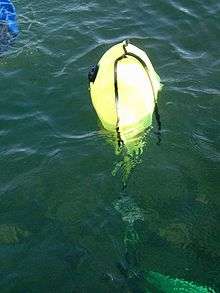 Small recreational grade lift bag.
Small recreational grade lift bag.- Medium duty 50kg lift bag
- Small Lift bag rolled up for transport
Closed lift bags (camels)

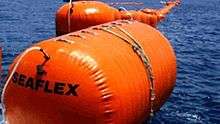
Closed lift bags have an overpressure valve to prevent internal pressure from exceeding ambient pressure by more than a set amount (around 10kPa, or 1msw)
Use
Types of lift for which bags are suitable
Direct lift
The bag or set of bags is used to lift the load directly to the surface.
Staged lift
Lift bags are used to bring the load up in stages: a long chain or sling is used to connect the cargo to a lift bag at a shallower depth, which is filled to lift the load until the bag reaches the surface, then a second bag is used to bring the load up further. This procedure continues until the load has been raised sufficiently. Advantages of this method are a more controlled lift, the facility to use a larger capacity for initial breakout without risk of a runaway. Disadvantages include the requirement for divers to work on or near the lifting gear when under load.
Buoyancy assisted lift
The lift is controlled by a line from the surface vessel, and the load is reduced by a lift bag with a volume too small to support the weight of the load when full. This allows a faster lift by the winch. The lifting gear must be capable of supporting the load if the bag fails, or must be arranged to fail safely.
A buoyancy assisted lift is a common procedure for recreational divers to assist the recovery of the shotline or anchor, which would otherwise be pulled up manually. A small lift bag attached to the shot is partially filled by the last diver to leave the bottom, and after surfacing the crew pull up the line and the air in the bag expands as it ascends, providing more assistance to the crew. In this application a runaway lift is not usually a problem, and the bag size is not critical.
Rigging lift bags
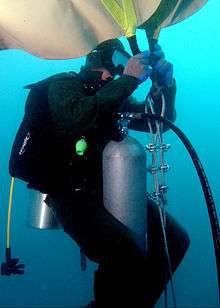
Lift bags can not be over inflated, and can not normally exert a buoyant force greater than their safe working load, however the rigging can be subjected to snatch loads, which can be caused by a variety of factors.
- When the bag is used in shallow water and surge or wave action causes rapid changes in dynamic loading, by pulling the bag from side to side
- When the bag has lifted the load to the surface and the bag is subjected to vertical wave action
- When the lift bag is incorrectly rigged
- When the lift bag is snagged, then breaks free to be snubbed when the slack is taken up.
- When the load is partly supported by a lifting cable and there is a sudden variation on the tension in the cable due to vessel movement or cable slip.
When lifting with more than one bag, allowance should be made for reduced filling capacity if bags are attached in such a way that they press against each other.
Incorrect rigging can cause load concentration on attachment points which may exceed the SWL
A inverter or capsizing line can be attached to the top of the bag. This line should be long enough and strong enough to attach to an independent anchor point so that if the lift bag or rigging fails the bag will be inverted and the air will escape, preventing a runaway lift. This procedure is generally used for short distance transport near the bottom, as when aligning large components for assembly.
A holdback line is used to prevent the lift bag and load from floating away when used for short distance lifts at the bottom. The holdback is attached to the lifting ring of the bag, and should be attached by a strong cable to an anchor point it cannot lift. The SWL of the holdback should be at least equal to the lifting capacity of the bag. A holdback and inverter are often used together.[1]
Filling lift bags
The amount of air required for a lift bag depends on the apparent weight of the load and the depth of the bag. Approximately 1 m3 of air at ambient pressure is required per tonne of lift. Free air volume follows Boyle's law, and is proportional to absolute ambient pressure in bar or ata.
For example: A 5 tonne lift with the bags to be filled at 20m, requires 5m3 of air at 3 bar, which is 15m3 at surface pressure.
Filling air is usually supplied from the surface from a low pressure compressor, but for small lifts the diver may carry a cylinder of air for the purpose. It is considered bad practice in some jurisdictions to fill a lift bag from the diver's breathing gas cylinder, particularly if the diver has decompression obligations or only one cylinder as the risk of using up too much air and leaving the diver without sufficient air for a safe ascent is considered unacceceptable.
Hazards of use
- Snagging of the diver or diver's umbilical or lifeline in the lifting equipment, resulting in an uncontrolled rapid ascent
- Using too much air from scuba diver's breathing gas supply, resulting in an out of air incident.
- Using too much volume in the lift bags, resulting in a positive feedback expansion on ascent and a runaway lift.
- Leaks in lift bags, causing loss of buoyancy and sinking of the load after lifting. The load may then sink increasingly rapidly as the air in the bags compresses, and may be a hazard to divers below or working on the load at the surface, or the load may be lost.
- Unbalanced attachment of lifting gear may cause the load to be unstable once lifted free of the bottom. subsequent capsize or shifting of the load may break it free of the rigging, or damage the load or the lift bag. Similarly poorly chosen or inadequate lifting points may result in overstressing the cargo and causing damage.
Gallery
 Divers releasing air from a lift bag underwater.
Divers releasing air from a lift bag underwater.- Divers on the surface with lift bags.
 Underwater archeologists position a lift bag to readjust shoring during the excavation of the U.S. sloop-of-war Scorpion.
Underwater archeologists position a lift bag to readjust shoring during the excavation of the U.S. sloop-of-war Scorpion. Training Navy divers in to operate lift bags.
Training Navy divers in to operate lift bags. Navy training exercise using lift bags.
Navy training exercise using lift bags.
External links
- Lift Bag Size/Volume Calculator - Online calculator to determine the lift bag capacity and air volume required to recover an underwater object from fresh or salt water.
References
- ↑ Underwater Air Lift Bags, IMCA D 016 Rev. 3 June 2007,The International Marine Contractors Association, www.imca-http://www.imca-int.com/divisions/diving/publications/016.html
![]() Media related to Lifting bags at Wikimedia Commons
Media related to Lifting bags at Wikimedia Commons
